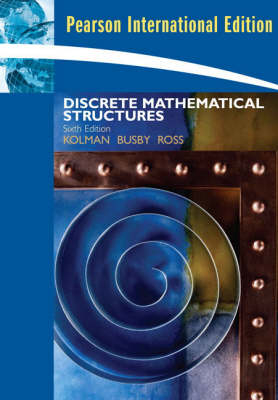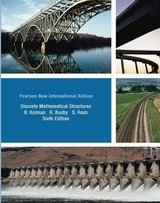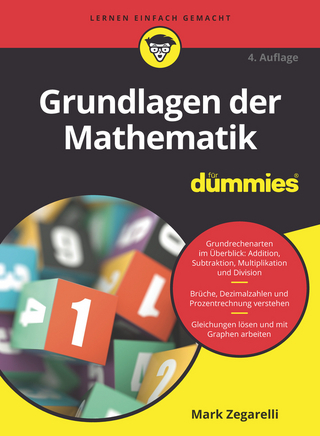
Discrete Mathematical Structures
Pearson (Verlag)
978-0-13-207845-0 (ISBN)
- Titel erscheint in neuer Auflage
- Artikel merken
This book is written at an appropriate level for a wide variety of majors and non-majors, and assumes a college algebra course as a prerequisite.
Bernard Kolman received his BS in mathematics and physics from Brooklyn College in 1954, his ScM from Brown University in 1956, and his PhD from the University of Pennsylvania in 1965, all in mathematics. He has worked as a mathematician for the US Navy and IBM. He has been a member of the mathematics department at Drexel University since 1964, and has served as Acting Head of the department. His research activities have included Lie algebra and perations research. He belongs to a number of professional associations and is a member of Phi Beta Kappa, Pi Mu Epsilon, and Sigma Xi. Robert C. Busby received his BS in physics from Drexel University in 1963, his AM in 1964 and PhD in 1966, both in mathematics from the University of Pennsylvania. He has served as a faculty member of the mathematics department at Drexel since 1969. He has consulted in applied mathematics and industry and government, including three years as a consultant to the Office of Emergency Preparedness, Executive Office of the President, specializing in applications of mathematics to economic problems. He has written a number of books and research papers on operator algebra, group representations, operator continued fractions, and the applications of probability and statistics to mathematical demography. Sharon Cutler Ross received a SB in mathematics from the Massachusetts Institute of Technology in 1965, an MAT in secondary mathematics from Harvard University in 1966, and a PhD in mathematics from Emory University in 1976. She has taught junior high, high school, and college mathematics, and has taught computer science at the collegiate level. She has been a member of the mathematics department at DeKalb College. Her current professional interests are in undergraduate mathematics education and alternative forms of assessment. Her interests and associations include the Mathematical Association of America, the American Mathematical Association of Two-Year Colleges, and UME Trends. She is a member of Sigma Xi and other organizations.
1. Fundamentals
1.1 Sets and Subsets
1.2 Operations on Sets
1.3 Sequences
1.4 Properties of Integers
1.5 Matrices
1.6 Mathematical Structures
2. Logic
2.1 Propositions and Logical Operations
2.2 Conditional Statements
2.3 Methods of Proof
2.4 Mathematical Induction
2.5 Mathematical Statements
2.6 Logic and Problem Solving
3. Counting
3.1 Permutations
3.2 Combinations
3.3 Pigeonhole Principle
3.4 Elements of Probability
3.5 Recurrence Relations 112
4. Relations and Digraphs
4.1 Product Sets and Partitions
4.2 Relations and Digraphs
4.3 Paths in Relations and Digraphs
4.4 Properties of Relations
4.5 Equivalence Relations
4.6 Data Structures for Relations and Digraphs
4.7 Operations on Relations
4.8 Transitive Closure and Warshall's Algorithm
5. Functions
5.1 Functions
5.2 Functions for Computer Science
5.3 Growth of Functions
5.4 Permutation Functions
6. Order Relations and Structures
6.1 Partially Ordered Sets
6.2 Extremal Elements of Partially Ordered Sets
6.3 Lattices
6.4 Finite Boolean Algebras
6.5 Functions on Boolean Algebras
6.6 Circuit Design
7. Trees
7.1 Trees
7.2 Labeled Trees
7.3 Tree Searching
7.4 Undirected Trees
7.5 Minimal Spanning Trees
8. Topics in Graph Theory
8.1 Graphs
8.2 Euler Paths and Circuits
8.3 Hamiltonian Paths and Circuits
8.4 Transport Networks
8.5 Matching Problems
8.6 Coloring Graphs
9. Semigroups and Groups
9.1 Binary Operations Revisited
9.2 Semigroups
9.3 Products and Quotients of Semigroups
9.4 Groups
9.5 Products and Quotients of Groups
9.6 Other Mathematical Structures
10. Languages and Finite-State Machines
10.1 Languages
10.2 Representations of Special Grammars and Languages
10.3 Finite-State Machines
10.4 Monoids, Machines, and Languages
10.5 Machines and Regular Languages
10.6 Simplification of Machines
11. Groups and Coding
11.1 Coding of Binary Information and Error Detection
11.2 Decoding and Error Correction
11.3 Public Key Cryptology
Appendix A: Algorithms and Pseudocode
Appendix B: Additional Experiments in Discrete Mathematics
Appendix C: Coding Exercises
| Erscheint lt. Verlag | 19.8.2008 |
|---|---|
| Sprache | englisch |
| Maße | 217 x 255 mm |
| Gewicht | 870 g |
| Themenwelt | Mathematik / Informatik ► Mathematik ► Allgemeines / Lexika |
| ISBN-10 | 0-13-207845-7 / 0132078457 |
| ISBN-13 | 978-0-13-207845-0 / 9780132078450 |
| Zustand | Neuware |
| Haben Sie eine Frage zum Produkt? |
aus dem Bereich



